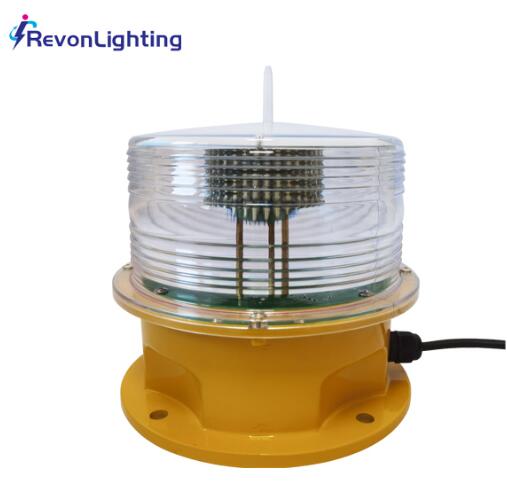Posted: 2024-07-29
In the realm of aviation, ensuring safe and precise operations is of utmost importance. One critical aspect of this is the use of beacon systems at heliports and airports. Specifically, the heliport beacon and heliport airport beacon light are essential tools that aid pilots in navigating and landing safely. This article delves into the significance, technology, and benefits of these beacons, illustrating their roles in modern aviation infrastructure.
Heliport Beacon: A Crucial Navigation Tool
The heliport beacon is an indispensable component of any heliport's lighting system. It serves as a visual guide for pilots, particularly during nighttime or low-visibility conditions. The primary function of the heliport beacon is to provide a high-visibility signal that helps pilots locate the heliport from a distance.
Typically, the heliport beacon emits a rotating or flashing light that can be seen from several miles away. This beacon is usually mounted on a tower or a mast and is designed to stand out against various environmental backdrops. By using different colors or patterns of light, the beacon helps to distinguish the heliport from other potential landing sites.
One of the key aspects of the heliport beacon is its ability to operate effectively under various weather conditions. Whether it's fog, rain, or snow, the beacon's robust design ensures that it remains visible and functional. Modern heliport beacons often use LED technology, which offers superior brightness and energy efficiency compared to traditional lighting methods.
Heliport Airport Beacon Light: Enhancing Safety at Airports
The heliport airport beacon light extends the functionality of beacons to airport environments where helicopters and fixed-wing aircraft operate. Unlike the standard heliport beacon, the heliport airport beacon light is tailored to provide guidance and safety for both helicopters and airplanes. This type of beacon is typically more versatile and often integrated into a comprehensive lighting system that covers various aspects of airport operations.

The heliport airport beacon light generally features a combination of high-intensity lights and distinct color patterns to ensure visibility across different distances. The design and placement of these lights are crucial for maintaining a clear visual reference for pilots approaching or departing from the airport. They also help pilots navigate complex airport layouts, including runways, taxiways, and parking areas.
One notable feature of the heliport airport beacon light is its adaptability to different operational requirements. For example, these lights can be programmed to display different colors or flash patterns depending on the time of day or specific operational needs. This adaptability enhances the overall safety and efficiency of airport operations, providing clear and reliable visual cues for pilots.
Technological Advancements and Benefits
The evolution of lighting technology has significantly impacted both heliport beacons and heliport airport beacon lights. Advancements such as LED technology have improved the brightness, efficiency, and durability of these beacons. LEDs offer several advantages over traditional lighting sources, including longer lifespans, lower energy consumption, and reduced maintenance requirements.
| Heliport Beacon | WE |
| ER | DF |
Another technological advancement is the integration of smart controls and monitoring systems. Modern beacons can be equipped with sensors and communication systems that allow for remote monitoring and control. This capability enables operators to adjust light intensity, color patterns, and operational schedules based on real-time conditions and operational requirements.
Safety and Operational Benefits
Improved Visibility: The primary benefit of heliport beacon and heliport airport beacon light systems is enhanced visibility. These beacons provide critical visual cues that help pilots locate heliports and airports, especially in challenging weather conditions or during nighttime operations.
Increased Safety: By offering clear and distinct visual signals, these beacons contribute to overall safety during landings and takeoffs. Pilots can better navigate their approach paths and avoid potential hazards, reducing the risk of accidents.
Energy Efficiency: Modern beacons, particularly those using LED technology, are highly energy-efficient. They consume less power and require less frequent maintenance compared to older lighting technologies, leading to cost savings and reduced environmental impact.
Adaptability: Heliport airport beacon lights can be customized to meet specific operational needs. Their flexibility in displaying different colors and patterns allows for effective communication of various operational statuses and requirements.
Challenges and Future Directions
Despite their many benefits, there are challenges associated with heliport beacon and heliport airport beacon light systems. Initial installation costs can be high, and ensuring compatibility with existing infrastructure may require careful planning. Additionally, the effectiveness of these beacons can be influenced by external factors such as weather conditions and surrounding light pollution.
Looking ahead, the future of beacon technology is promising. Ongoing research and development are likely to yield even more advanced lighting solutions, incorporating innovations such as adaptive lighting systems and enhanced energy storage. These advancements will further improve the safety, efficiency, and sustainability of heliport and airport operations.
In summary, the heliport beacon and heliport airport beacon light play vital roles in modern aviation by providing essential visual guidance for pilots. Their advancements in technology and design have greatly enhanced safety, visibility, and operational efficiency at heliports and airports. As the aviation industry continues to evolve, these beacon systems will remain integral to ensuring safe and effective flight operations, reflecting the industry's commitment to innovation and excellence.